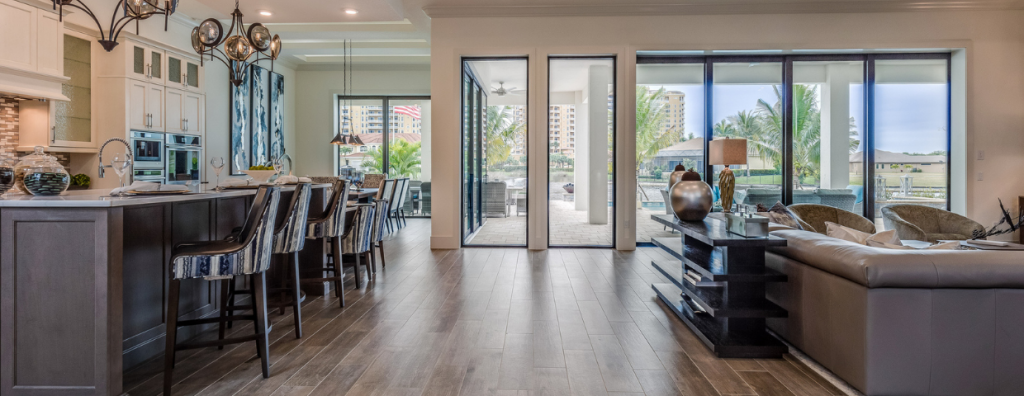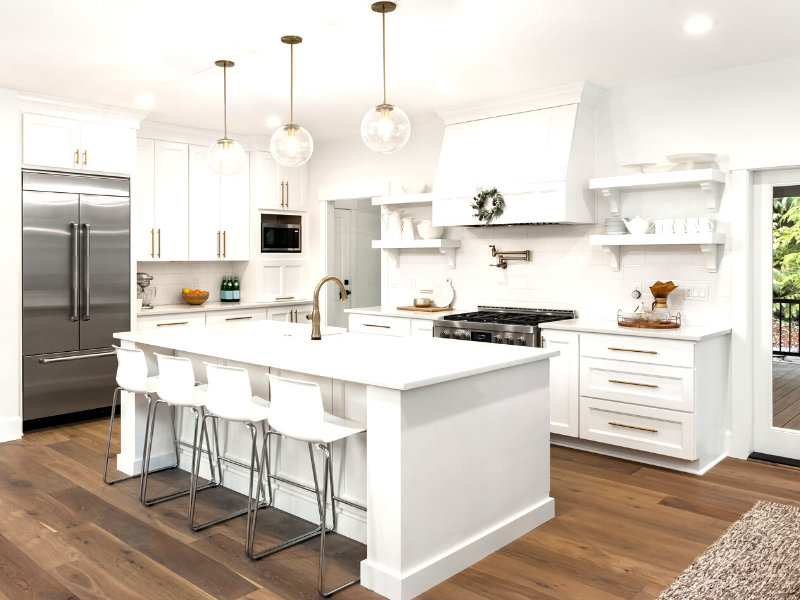Must-Haves and Nice-To-Haves Lists

Finding your dream home may not be easy, but there are things you can do to make it easier, like creating a “Must-Haves” list and a “Nice-To-Haves” list. These lists allow serious home buyers to save time, energy, and ultimately, money as they prepare to buy a home.
A Must-Have List is exactly what it sounds like, a checklist of the details that are non-negotiable for your new home. It’s essential to sit down and think about the things you need in order to feel comfortable there for the next 7-13 years.
Your “Nice-To-Haves” list is a checklist of details that you’d like to have, but you can live without. This list is great for those things that you’ve always dreamed of but may be out of reach for reasons such as your budget or location. This list may include things like fireplaces or gas appliances, a pool, or other non-essential items.
Your “Must-Haves” list focuses your search and helps your agent narrow down which homes are worth your time. Your “Nice-to-Haves” list will help you determine what you’re willing to sacrifice, which will ultimately solidify your must-haves.
These lists can also help manage your expectations regarding price. Take your lists to your real estate agent, along with your pre-approval from a lender, and you’ll be able to work together to determine what is a reasonable ask within your budget and your desired location.
Creating Your “Must-Haves” List
The first step is to think about the essentials. If things like location and number of bedrooms and bathrooms are a priority, then you’ll want to include them in your must-haves. Consider where you live now and use that as a starting point; what do you love and what are you missing? You may need more storage space, or an extra room to work remote, or a larger backyard for the newest member of the family.
Here are some questions to ask yourself as you build your “Must-Haves” list:
- Where do you want to live? (Be as specific as you can.)
- What do you have now that you can’t live without?
- What are you missing now that you may need for the next several years?
If you’re struggling to determine what it is you need to have, you can start working on your “Nice-To-Haves” list. This can also help you determine what is essential. For example, it may be nice to have five bedrooms when in reality, a three-bedroom house with a flex space that works for an office or guest room would do the trick.
Creating your “Nice-To-Haves” List
While you’re working on your “Nice-To-Haves” list, you’ll be thinking about the parts of a home that would be great to have but aren’t as important for you. You might also want to take into consideration what is reasonable in your area and if it’s a common amenity.
Here are some questions to ask yourself as you build your “Nice-To-Haves” list:
- What home upgrades are you willing to make?
- What is something you’d like to do in your house more often?
- What do you have in your current home that you love, but don’t need?
Searching for Your Next Home
These lists will help guide you and your real estate agent as you search for your next home. During this process you might realize some aspects aren’t as important to you as you thought, and vice versa. Keep your agent in the loop as you update your lists so they can continue to search for the perfect home for you.
Looking for a real estate agent who can help guide you through the home buying process? Connect with an Agent:
How to Choose the Best Flooring

Flooring is a key component of a home’s design and can often be the centerpiece of a renovation or remodel. Because it covers such a large surface area it will significantly impact the look and feel of your home, so choosing the right material can be stressful. Weigh your options before making a decision. Learn about the different types of material, assess your budget, and form a plan for installation.
How to Choose the Best Flooring
Room Function
How you spend time in any given room will help you decide which type of flooring is best. In your home office, choose the flooring that best accommodates your working needs. Carpet can be comforting while hardwood and laminate are more durable. Entryways, mudrooms, playrooms, and pet rooms will undoubtedly see their fair share of dents, cracks, and dings, so a resilient material is best for these areas. Consider materials that are strong and easy to clean, such as tile. The kitchen is a high-traffic area that is constantly being cleaned and re-cleaned. Explore solid yet easy to clean materials like vinyl, hardwood, and ceramic tile. If these common flooring materials aren’t to your liking, certain alternative flooring options may appeal to you, including bamboo, cork, and concrete.
Budget
Your budget will be a major deciding factor in which type of flooring you ultimately install. Are you replacing your flooring as part of a larger, full-scale remodel? If so, there may be other projects that will warrant a larger share of your budget. Are you looking to make the flooring a selling point of the home? If so, you’ll likely dedicate more money towards the material and installation. Talk to your agent about which types of flooring have the best resale value and what buyers in the area are looking for. For example, if you live in a climate that experiences cold temperatures, heated flooring may give your home a competitive advantage over other listings when it comes time to sell.
Installation
There are two approaches to a flooring installation: DIY or professional. Installing your flooring on your own is a great way to save money on the project, but it’s also a lot of added responsibility. Before making the decision to install on your own, understand the risks involved with the project and the time it will take to complete it. Vinyl and laminate flooring tend to be easier to install DIY. Hiring a professional will come with increased costs, but you’ll be paying for higher quality work that will increase the value of your home. More involved flooring installations such as hardwood are usually best handled by a pro.
Style & Color
After your budget has been set and you’ve decided on how to install, then comes the fun part. When choosing the style of your flooring, think about how it will interact with the space. Will the flooring be the focal point of the space? Will it compliment the features of the room and the surrounding décor? Knowing these answers will help to sort out the fine details, such as the specific shade of tile or the grain of wood.
Maintenance
At the end of the day, you may simply be looking for flooring that’s easy to take care of. In that case, explore common low-maintenance materials like vinyl and laminate. Vinyl flooring—whether it’s tile, sheet, plank, or peel-and-stick—requires little care compared to high-maintenance flooring such as solid or engineered wood.
For more information on home design, visit our Design page. To learn more about interior design, visit our Design Styles page.
Renovating Your Short-Term Rental

Renovating your short-term rental property will not only keep it in peak condition but will also help it stand out to potential renters. Completing remodeling projects with the goal of increasing the return on your investment is a matter of identifying which renovations make sense for the home, putting together a plan, and taking steps to minimize the risk of the projects going over budget.
Start with Repairs
Because rental properties are by nature a source of income, it’s worth your while as the homeowner to reduce maintenance costs wherever possible. This can often mean spending money in the short term on repairs and replacements in order to save money down the road. Furthermore, by upgrading your appliances, fixing leaks, and updating any outdated features, you will provide the most accommodating environment for your renters. Making these improvements can also help set your rental apart from other properties, giving you a competitive advantage in the market. As you go about making repairs, don’t forget to check the working condition of all faucets, electrical outlets, and lights.
Renovating Your Rental
Understanding the scope of your renovations and the motivation behind them before you get started will help formulate your plan moving forward. Are you looking to upgrade the home to sell it in the future? Are you renovating to increase rent? Or are you simply looking to be more competitive in the local rental market? Knowing the answers to these questions won’t necessarily change your renovation plans, but it will provide guidance as you enter the remodeling phase. Consider talking to your Windermere agent about how different projects may affect the value of the property.
Even a small-scale renovation can make a big difference in the minds of renters. To create the best first impression from the get-go, consider boosting your home’s curb appeal. Projects like exterior painting, refinishing a deck, and power washing your siding and walkways will help provide an inviting outdoor setting for your renters.
When it comes to interior renovations, kitchens are a great place to start. Thankfully, kitchen makeovers can be simple. Identify the areas of your kitchen that need repair first, then expand your project list from there. Next, consider upgrading the bathroom. Begin by checking your pipes, drains, and p-traps for any signs of wear and tear. Simple things like painting the vanity and updating the bathroom hardware can also make a big impact.
Last but not least, if you decide to hire a professional to renovate your rental property, be sure to gather multiple bids and compare prices before making your final decision.
Learn more about the pros and cons of investing in vacation rentals here: Vacation Home or Income-Producing Investment. You can also read about vacation home renovations by season here: Renovating Your Vacation Home.
Relocating for Remote Work

As the ubiquity of working from home continues, many homeowners are making the decision to move. Whether the motivation for relocating is to lower the cost of living, to be closer to family, or simply a fresh start, there are various factors to keep in mind when relocating for remote work.
Before You Relocate
Before you make the jump to a new life in a new place, making time for some strategic planning will help ensure your relocation goes as smoothly as possible. A logical first step is to consider the financial impact of your move. Depending on your company’s policy, there may be adjustments to your pay when you relocate. If this is the case, factor in your pay change as you form your relocation budget. Research the cost of living in your new hometown to understand how a compensation adjustment may affect your home search and your lifestyle once you move.
If you are moving out of state, relocating could affect your benefits and your taxes as well. There’s a chance that your employer’s health insurance plan does not offer coverage in the state you’re moving to. Talk to your employer to discuss your options. Before moving out-of-state, find out whether the two states have a reciprocal tax agreement, especially if you’re moving between states that have differing income tax regulations.
Your New Home for Remote Work
Working remote has given homeowners the freedom to choose their desired location, unbound by a work commute, especially if their company has indicated that there are no clear signs of returning to in-person work anytime soon. Knowing your desired work environment will help to tailor your home search. If you’re looking for peace and quiet while you work, explore listings in rural areas. If the hubbub of city life is your idea of a comforting backdrop, direct your attention to metropolitan areas.
For the remote worker, it’s more important than ever that your home accommodates your working needs. As many homeowners have experienced throughout the pandemic, you spend a great deal of time in your home office, so finding the home with the best workspace for you should be a priority. If you desire a private area where you can focus, a home with an open floor plan may not be the best choice. Instead, you may want to look for homes with a separate bonus room or extra bedroom.
Once you’ve moved into your new home, it’s time to put together your home office. Whether your previous home office was a professionally curated environment or a makeshift workspace in the corner of a room, a new home means a fresh start for your remote work. Like many homeowners, by now you’ve likely got a solid grasp on what your ideal home office looks like. Keep those elements alive when you relocate and enjoy productive workdays in your new home.
The Importance of Pre-Approval

To set yourself up for a smooth and successful home purchase, getting pre-approved is perhaps the most productive first step you can take. It strengthens your buying credibility, informs your home search, and speeds up the closing process.
The Pre-Approval Process
There is an important distinction to made between two important steps of your mortgage application process: pre-qualification and pre-approval. They are similar in that they both help to inform your financial standing, but there are key differences between the two.
Pre-qualification
Pre-qualification is the first step in your mortgage application process. It will help you to understand the approximate loan amount you can expect to qualify for. You’ll begin by sharing your financial information—debt, income, assets, etc.—with you bank or lender. After reviewing the information, the bank or lender will give a loan estimate. The process is relatively simple, only taking a few business days to process.
Pre-approval
The pre-approval process is more involved than pre-qualification. After submitting a mortgage application, your lender will require all the necessary info to conduct a thorough credit history check and review of your financial health. Getting pre-approved will give you a better idea of how much you can borrow, estimated monthly costs, and what interest rates you can expect on your loans. Mortgage pre-approvals are typically valid for 60 to 90 days.
Benefits of Pre-Approval
Credibility
The truth is, each home on the market can only go to one buyer. To maximize the chance that your offer is accepted, sellers need to know that your offer is serious. Getting pre-approved shows that you are financially prepared and, in the event that your offer is accepted, there will be no hold ups in obtaining your mortgage. This assurance is what sellers want to know about their potential buyers, especially in a seller’s market.
Home search
Not only does pre-approval help to bolster your case as a buyer, but it also Indicates your affordable price range. By knowing your budget, you will be able to hone your home search and start preparing offers, eliminating any potential wasted time looking at houses you can’t afford.
Closing process
Once your offer is accepted, you’ll be counting down the days to move-in. Unfortunately, the closing process can often drag on, leaving buyers feeling like they’re in post-purchase limbo. Pre-approval will speed up the closing process, since the mortgage approvals have already been taken care of, allowing you to focus on next steps like appraisals and inspections.
When to Get Pre-Approved
Being financially prepared for a home purchase is a solid indicator that you’re ready to go about getting pre-approved, but what does that look like? Buying a house means taking on serious debt, so it’s important to either have your remaining debt paid off or have a clear path to becoming debt-free before getting pre-approved. Having adequate savings for a down payment is a sign that you’re ready to make your offer. For any questions about the pre-approval process and to get connected to a mortgage professional, contact your Windermere agent.
DIY Remodeling vs Professional Remodeling

Deciding whether to DIY a remodeling project or leave it to a professional is a matter of weighing the risks and rewards, time, and budget. Before you start applying a new coat of paint or go about knocking down a wall, create a plan for your remodel to help you decide which projects you can handle, and which ones belong in the hands of a pro.
Create Your Remodeling Plan
Knowing your plans for your remodel will help to determine your timeline and budget, which will inform your DIY-vs-Pro decision-making. Set specific goals for each project so you’ll know when you’re getting off track but remain flexible in your planning to leave room for any unexpected hurdles that will inevitably pop up in the remodeling process. Your budget will also help you decide who should execute certain projects. For example, if you’re budgeting more for a kitchen remodel than any other project, that is a likely candidate for professional help.
If you’re having trouble deciding the best route to take with your remodeling projects, ask yourself the following questions:
- What risks am I comfortable taking on?
- How much time am I willing to dedicate to this project?
- Does this project require a permit?
- Do I have any experience with this kind of remodel?
- Am I comfortable giving up control of this project?
DIY Remodeling Pros and Cons
Pros: Taking a DIY approach to remodeling projects pays dividends in many ways. Without having to pay labor costs, you stand to save significant money by tackling a project on your own. Going DIY also allows you to set your own schedule for the project. And of course, the sense of ownership and pride you will feel knowing you completed the project on your own is a priceless feeling for a homeowner.
Cons: DIY projects can be consequential. Mistakes at any point in the renovation process can lead to greater costs and sometimes, hiring a professional to fix the mistake. Unfortunately, this can result in the loss of significant time and money.
Professional Remodeling Pros and Cons
Pros: Professionals are inherently more experienced, bringing their specialization to the table on every home renovation project, so you can expect them to perform high-quality work that will increase the value of your home.
Cons: Getting professional quality work means paying for it. When budgeting, expect higher costs for any project you’re thinking of outsourcing to a pro. Bear in mind that, especially for large-scale renovation projects, your home will become a construction site. Accordingly, you may need a back-up plan, such as a temporary kitchen set-up or a short-term rental home .
DIY Remodeling vs Professional Remodeling: Around the House
The following list breaks down which projects are typical DIY candidates and which ones homeowners commonly opt for professional help to complete. However, the decision is ultimately up to you. If you have your heart on tackling a project on your own, gather your tools and make it happen!
Kitchen
- Professional: Any large-scale structural changes, new gas lines, or new plumbing projects should be handled by a professional.
- DIY: Simpler kitchen projects like a backsplash or faucet replacement and any cabinet finishing tasks are perfect DIY candidates.
Bathroom
- Professional: Plumbing installation, running electricity, or any projects involving an expansion or alteration to your bathroom structure.
- DIY: If your bathroom is simply in need of some new tile work, basic medicine cabinet restoration, or minor flooring improvements, roll up your sleeves and DIY.
Backyard
- Professional: Consider hiring a professional for any significant outdoor projects like concrete builds, in-ground pools, and technical deck work.
- DIY: Common backyard DIY projects include building a garden tool shed, building a fence, and refinishing a deck.
General
- Professional: It is best to hire pros for new roofing, any foundation work, and extensive demolition projects. For asbestos and drywall finishing, it’s easiest, and safest, to go with the pros.
- DIY: Any interior painting projects, basic electrical work, or simple trim and door upgrades.
If you’re planning on going through a remodel while you live at home, read this first. For more information on how certain renovations may impact the value of your home, talk to your Windermere agent.
10 Costs Associated with Selling Your Home

Selling a home is an exciting time for homeowners. Once you and your household have decided that you’ll hit the market, it’s easy to think solely about the revenue that comes with the sale. However, selling a home comes with its own set of costs. Knowing what these costs are will help you budget throughout the selling process.
Here are 10 most of the most common costs that come with selling a home:
1. Commission fees
Of all the expenses that come with the sale of a home, agent commission fees are usually the largest and for good reason. Real estate agents are professionals, wielding their industry knowledge and local expertise to get the job done and save countless hours of work for the homeowner. The commission is split by the agents representing both buyer and seller, typically totaling between five and six percent of the sale price.
2. Pre-sale home inspection
Pre-sale home inspections are not mandatory, however, if a seller does not conduct one, it could lead to major costs down the road. The inspection allows the seller to find any issues with the home and properly disclose them to the buyer. If the buyer’s home inspector finds repairs that need to be made, they can ask the seller for a price reduction or require that they be fixed in order for the sale to go through.
3. Home repairs
There are varying degrees of home repairs that can increase the value of your home. Cosmetic fixes like improving your landscaping will do wonders for your curb appeal. Painting and decluttering help to present the home in the best light for buyers. Larger projects like replacing appliances, roofing, plumbing, and full-scale upgrades are a more significant investment but can increase your home’s value.
4. Staging costs
During the selling process, it pays to put effort into the presentation of your home. Staging helps buyers to visualize living in the home. Professional stagers will enhance your home’s qualities while minimizing its deficiencies. Their cost will depend on the level of staging your home requires.
5. Utilities
In the interim period between when you move out and the buyers move in, you’ll want to continue paying utilities. Without running water, electricity, and heat, your home could be difficult to show to buyers.
6. Remaining mortgage
Another cost of selling your home is the remaining loan balance on your mortgage. If you have been steadily paying your mortgage, your home sale will greatly aid in paying back the remaining amount, if not cover it completely.
7. Escrow fees
In a home sale, there’s always the question: Who handles the cash? That’s where escrow comes in. It’s common for buyers and sellers to split the cost of escrow services. Be mindful of additional costs during escrow such as transfer fees and notary services.
8. Capital gains tax
The capital gains tax is assessed by taking the difference between what you paid for your house and what you sold it for. There are common exclusions for the tax, but there are situations where the exclusions may not apply. For example, if the home was not your primary residence, you could end up paying taxes on the whole gain. Talk to your Windermere agent for more information.
9. Property tax
If your home sale takes place after you’ve paid taxes for the year, you may get a rebate at closing. In this case, the buyer reimburses the seller for the applicable taxes paid. Otherwise, the seller should pay the prorated share of property tax until the sale closes, placing the money in escrow.
10. Moving costs
Finally, the home sale is final, and you’re ready to move. Whether you’re moving locally or across the country, moving costs can add up quickly. Moving as many of your items yourself can save money, but for larger, more difficult to transport items, you’ll likely need to incur the cost of hiring professional movers to ensure your items arrive at your new home safely.
These are just some of the costs associated with selling your home. Each home sale is different, and the costs vary accordingly. Knowing what you can expect to spend throughout the selling process will help you budget accordingly.
Empty Nesters: Remodel or Sell?


Your kids have moved out and now you’re living in a big house with way more space than you need. You have two choices – remodel your existing home or move. Here are some things to consider about each option.
Choice No. 1: Remodel your existing home to better fit your current needs.
- Remodeling gives you lots of options, but some choices can reduce the value of your home. You can combine two bedrooms into a master suite or change another bedroom into a spa area. But reducing the number of bedrooms can dramatically decrease the value of your house when you go to sell, making it much less desirable to a typical buyer with a family.
- The ROI on remodeling is generally poor. You should remodel because it’s something that makes your home more appealing for you, not because you want to increase the value of your home. According to a recent study, on average you’ll recoup just 64 percent of a remodeling project’s investment when you go to sell.
- Remodeling is stressful. Living in a construction zone is no fun, and an extensive remodel may mean that you have to move out of your home for a while. Staying on budget is also challenging. Remodels often end up taking much more time and much more money than homeowners expect.
Choice No. 2: Sell your existing home and buy your empty nest dream home.
- You can downsize to a single-level residence and upsize your lifestyle. Many people planning for their later years prefer a home that is all on one level and has less square footage. But downsizing doesn’t mean scrimping. You may be able to funnel the proceeds of the sale of your existing home into a great view or high-end amenities.
- A “lock-and-leave” home offers more freedom. As your time becomes more flexible, you may want to travel more. Or maybe you’d like to spend winters in a sunnier climate. You may want to trade your existing home for the security and low maintenance of condominium living.
- There has never been a better time to sell. Our area is one of the top in the country for sellers to get the greatest return on investment. Real estate is cyclical, so the current boom is bound to moderate at some point. If you’re thinking about selling, take advantage of this strong seller’s market and do it now.
Bottom Line
If your current home no longer works for you, consider looking at homes that would meet your lifestyle needs before taking on the cost and hassle of remodeling. Get in touch with a Windermere Real Estate broker to discuss the best option for you.
Kick-Starting a Kitchen Remodel


Ask a homeowner which room they would most like to improve, and most will point to the kitchen – the starting point for every meal and the heart of the home.
Ask those same people why they don’t move forward with a kitchen remodel, and many will say the project seems so overwhelming they don’t know where to start. If your kitchen needs an upgrade, here are some step-by-step suggestions to get you started.
Gather your thoughts
The steps that follow will all progress much easier if you take time beforehand to form a strong opinion about the desired look and layout of your new kitchen.
Start by reviewing kitchen magazines and photo-heavy kitchen remodeling guides and/or websites. Compiling clippings and printouts in a notebook helps you refine your vision. Clip or print the photos that capture your imagination, add notes, and draw circles and arrows around the things you like most.
Once you have a clearer vision of what you want, search online for better examples and new solutions, if necessary. If you live with a significant other, share your ideas with them and don’t allow yourself to become too committed before getting buy-in from them. Contractors and sales associates will expect a unified front.
Focus on the flow
Another major factor you’ll want to consider is how your new kitchen will be used, and by whom:
- Do you want to cook with others?
- Do you want family and guests to gather in the space while you cook?
- Do you want to serve meals in the kitchen?
- Do you want to display your dishware?
- Where would you like things stored for maximum efficiency?
Imagine yourself happily cooking and entertaining in your new kitchen, then note the key elements necessary to make those dreams a reality. Having a list of your desired kitchen features and storage needs will help ensure your plan meets your vision.
Determine your budget
According to the annual Remodeling Magazine survey of costs, a “midrange,” “minor” kitchen remodel will cost homeowners living on the West Coast about $23,000. Those same folks can expect to pay about $70,000 for a midrange “major” kitchen remodel. Determine what you can afford before you start work to ensure that your vision is within reach, or to help prioritize what’s most critical.
What to do with the cabinets
Replacing the cabinets is one of the most expensive improvements you can make in a kitchen remodel (typically consuming 20 to 40 percent of the overall budget, according to Architectural Digest).
Consider refacing instead. This can include one of the following: 1) Installing completely new cabinet doors and drawer fronts or 2) installing new wood or laminate veneer over the existing cabinet and drawer fronts or 3) simply refinishing the existing cabinet and drawer fronts.
Shopping for contractors
The contractor you choose will determine much of the cost, the pace of your project, the amount of disruption, the final results, and your level of satisfaction. So be thorough in your search:
- Ask friends and family for referrals and advice.
- Interview at least three of the leading prospects in-person.
- Ask to see samples of past work.
- Look for someone who complements your operating style (similar personality and communication style).
- Once you’ve narrowed your choice to one or two, ask to speak with a few past clients.
You’ll be tempted to latch onto the first contractor who gets rave reviews from a friend or family member. But remember: You and your project are unique, and it’s worth the time and effort to be rigorous in your search.
Selecting appliances
If you’re planning to replace appliances, here are three factors you’ll want to consider:
Finish – Stainless steel is still the most popular option, but beware: smudges, fingerprints, water spots, and streaks will be obvious. Black stainless steel has a warmer feel and is better at hiding spots.
Extended warranty – According to Consumer Reports, extended warranties are hardly ever worth it because today’s appliances are so reliable. And if something does fail, it’s often less expensive to just pay for the repair.
Unbiased testing and reviews – Before making an appliance purchase, use the information resources available through Consumer Reports.
A final note
Moving walls and extending your home’s foundation are both very expensive options. If your kitchen plans call for these architectural renovations, perhaps you’ve outgrown your home and need something larger (with an already-improved kitchen).
 Facebook
Facebook
 Twitter
Twitter
 Pinterest
Pinterest
 Copy Link
Copy Link





